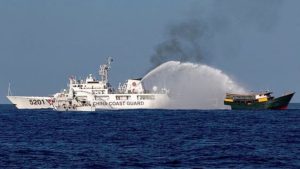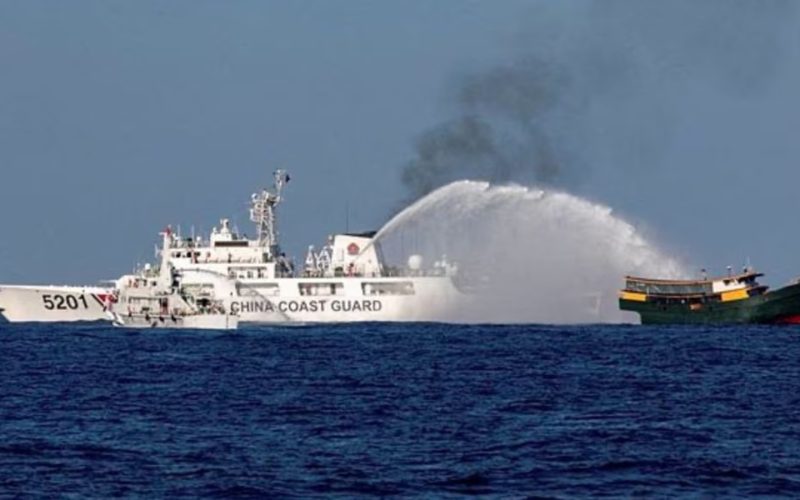The South China Sea dispute is a complex and longstanding issue involving multiple countries with overlapping territorial claims. The Philippines, one of the key stakeholders in this conflict, has recently issued a stark warning about the potential for a region-wide conflict if the disputes are not resolved peacefully. This article explores the background of the South China Sea dispute, the Philippines’ position, the potential for conflict, and the implications for regional and global stability.
Background of the South China Sea Dispute

The South China Sea is a strategic and resource-rich area, with significant economic and geopolitical importance. Several countries, including China, the Philippines, Vietnam, Malaysia, Brunei, and Taiwan, have overlapping claims to various parts of the sea. These claims are based on historical evidence, international law, and strategic interests.
China’s expansive claims, delineated by the so-called “nine-dash line,” cover most of the South China Sea and are contested by other claimants. The region is rich in oil and natural gas reserves, and it is also a major shipping route, with approximately one-third of global maritime trade passing through its waters. Additionally, the area is abundant in fisheries, making it a vital resource for the livelihoods of millions of people in the surrounding countries.
The Philippines’ Position
The Philippines has been one of the most vocal opponents of China’s claims in the South China Sea. In 2016, the Philippines won a landmark case at the Permanent Court of Arbitration in The Hague, which invalidated China’s claims to much of the South China Sea. However, China has refused to recognize the ruling and has continued to assert its presence in the disputed waters through military and civilian activities.
The Philippines, under President Rodrigo Duterte’s administration, initially adopted a more conciliatory approach towards China, seeking economic cooperation and investment. However, recent developments have led to a more assertive stance. The Philippines has increased its military presence in the disputed areas and has called for stronger international support to counter China’s actions.
Recent Developments and Rising Tensions
Tensions in the South China Sea have escalated in recent years, with increased military activities by China, the United States, and other regional powers. China has built and militarized artificial islands, deployed military assets, and conducted naval exercises in the disputed waters. These actions have been met with condemnation and increased military patrols by the United States and its allies, including freedom of navigation operations.
In April 2024, the Philippines issued a warning about the potential for a region-wide conflict over the South China Sea disputes. This warning came after a series of incidents, including confrontations between Chinese and Philippine vessels and the presence of Chinese maritime militia in areas claimed by the Philippines. The Philippines has called for greater international cooperation to ensure freedom of navigation and overflight in the South China Sea and to uphold international law.
Analysis of Potential Conflict Scenarios
The possibility of a region-wide conflict over the South China Sea is a significant concern for regional and global stability. Several scenarios could lead to an escalation of tensions and potential conflict:
- Accidental Clashes: Incidents involving naval or aerial collisions between military assets of the claimant countries could quickly escalate into broader conflicts. The lack of clear communication channels and mechanisms for conflict resolution increases the risk of accidental clashes.
- Militarization and Arms Race: The continued militarization of the South China Sea and the buildup of military capabilities by regional powers could lead to an arms race and heightened tensions. The deployment of advanced weaponry and military infrastructure increases the risk of miscalculations and conflicts.
- Economic and Resource Competition: The competition for resources, including oil, natural gas, and fisheries, could lead to confrontations between claimant countries. Unilateral actions to exploit these resources without agreements or cooperation could trigger conflicts.
- Involvement of External Powers: The involvement of external powers, particularly the United States, in the South China Sea disputes adds another layer of complexity. The United States has conducted freedom of navigation operations and strengthened alliances with regional countries, which could lead to confrontations with China.
Comparative Analysis Table
The following table compares the key stakeholders in the South China Sea dispute, highlighting their claims, actions, and positions:
| Country | Claims and Actions | Position and Strategy |
|---|---|---|
| China | Claims most of the South China Sea based on the “nine-dash line”; built and militarized artificial islands. | Asserts historical rights; refuses to recognize international rulings; increases military presence; engages in economic diplomacy with claimant countries. |
| Philippines | Claims parts of the Spratly Islands and Scarborough Shoal; won the 2016 arbitration case against China. | Advocates for international law and peaceful resolution; increases military presence; seeks international support; balances relations with China and the U.S. |
| Vietnam | Claims parts of the Spratly and Paracel Islands; involved in confrontations with Chinese vessels. | Strongly opposes China’s claims; builds military capabilities; seeks international alliances and support; engages in diplomatic negotiations. |
| Malaysia | Claims parts of the Spratly Islands and other maritime features. | Pursues diplomatic and legal avenues; increases military patrols; engages in bilateral and multilateral dialogues to manage disputes. |
| Brunei | Claims parts of the Spratly Islands; least vocal among claimants. | Advocates for peaceful resolution through ASEAN; seeks to avoid direct confrontations; engages in diplomatic efforts. |
| Taiwan | Claims most of the South China Sea based on historical maps; controls Taiping Island. | Similar claims to China; focuses on maintaining presence on Taiping Island; limited international support due to political status. |
| United States | Conducts freedom of navigation operations; strengthens alliances with regional countries. | Supports international law and freedom of navigation; opposes China’s claims and actions; enhances military presence in the region; engages in diplomatic efforts. |
Implications for Regional and Global Stability
The potential for a region-wide conflict over the South China Sea disputes has far-reaching implications for regional and global stability. The South China Sea is a critical maritime area, and any conflict would have significant economic, political, and security consequences.
- Economic Impact: A conflict in the South China Sea would disrupt global trade routes, leading to economic instability and increased costs for shipping and insurance. The region’s rich natural resources, including oil, natural gas, and fisheries, would also be at risk, affecting global energy and food security.
- Political and Diplomatic Tensions: A conflict would exacerbate political and diplomatic tensions among claimant countries and their allies. It would strain regional cooperation mechanisms, such as the Association of Southeast Asian Nations (ASEAN), and could lead to a realignment of alliances and partnerships.
- Security and Military Escalation: A conflict in the South China Sea would likely lead to a military escalation, involving regional powers and potentially drawing in external powers like the United States. The risk of a broader regional conflict, including potential confrontations between major military powers, would increase significantly.
- International Law and Order: A failure to resolve the South China Sea disputes peacefully would undermine international law and order, particularly the United Nations Convention on the Law of the Sea (UNCLOS). It would set a dangerous precedent for the resolution of maritime disputes and could encourage other countries to pursue unilateral actions.
Analysis Table: Potential Conflict Scenarios
| Scenario | Description | Implications |
|---|---|---|
| Accidental Clashes | Incidents involving naval or aerial collisions between military assets of claimant countries. | High risk of escalation; lack of communication channels and resolution mechanisms increases danger. |
| Militarization and Arms Race | Continued buildup of military capabilities and infrastructure in the South China Sea. | Heightened tensions and risk of miscalculations; increased likelihood of confrontations and conflicts. |
| Economic and Resource Competition | Unilateral actions to exploit resources, including oil, natural gas, and fisheries. | Potential for resource-related confrontations; disruption of economic activities and livelihoods. |
| Involvement of External Powers | Increased military and diplomatic involvement of external powers, particularly the United States. | Greater complexity and risk of confrontations; potential for broader regional conflict involving major military powers. |
Comparative Table: Key Stakeholders in the South China Sea Dispute
| Country | Claims and Actions | Position and Strategy |
|---|---|---|
| China | Claims most of the South China Sea based on the “nine-dash line”; built and militarized artificial islands. | Asserts historical rights; refuses to recognize international rulings; increases military presence; engages in economic diplomacy with claimant countries. |
| Philippines | Claims parts of the Spratly Islands and Scarborough Shoal; won the 2016 arbitration case against China. | Advocates for international law and peaceful resolution; increases military presence; seeks international support; balances relations with China and the U.S. |
| Vietnam | Claims parts of the Spratly and Paracel Islands; involved in confrontations with Chinese vessels. | Strongly opposes China’s claims; builds military capabilities; seeks international alliances and support |
Conclusion
The South China Sea dispute remains a critical flashpoint in the Asia-Pacific region, with significant implications for regional and global stability. The Philippines’ warning of a region-wide conflict underscores the urgency of finding a peaceful and sustainable resolution to the disputes. It is essential for all claimant countries and external powers to engage in diplomatic efforts, uphold international law, and promote regional cooperation to prevent the escalation of tensions and ensure peace and stability in the South China Sea.











